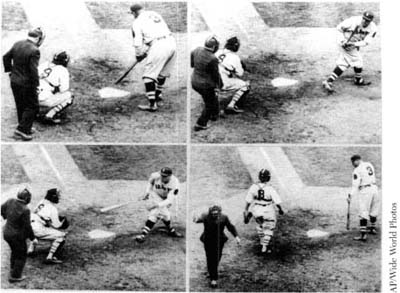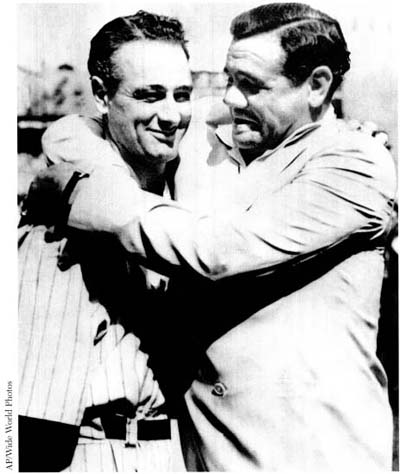Babe Ruth: Legends in Sports (6 page)
Read Babe Ruth: Legends in Sports Online
Authors: Matt Christopher

Home run! Yankee Babe Ruth, the Sultan of Swat, clouts one into the stands in this undated photo.

Babe Ruth makes baseball history when he slugs in his sixtieth home run on September 30, 1927.

A rare shot of the Babe sliding into home plate. Usually he arrived standing up!

Even Babe Ruth’s strikes were powerful! In upper left corner, he taps the plate. In upper right, he swings and misses for
strike one. Strike two follows, then strike three and he’s out.

Babe Ruth embraces an emotional Lou Gehrig on July 4, 1939—the day Gehrig called himself “the luckiest man in the world.”

Fans always flocked to Babe for autographs. In 1947, he signed a ball for a young female ballplayer.
The following year, the cocky Yankees figured they’d win another world championship in 1924 just by showing up. Although Ruth
had started drifting back to his old ways and was again gaining weight, most observers figured that the Yankees still had
more than enough firepower and pitching to win.
But the overconfident Yankees got off to a slow start. Before the season they foolishly released pitcher Carl Mays. He later
won twenty games for Cincinnati while the Yankee pitching staff fell apart. By mid-season the Yankees were battling Washington
and Detroit for the pennant.
Ruth, however, was having another great year, just a shade below his performance in 1923. Still, despite cracking 46 home
runs and hitting .378, he couldn’t put the Yankees over the top. They finished second.
Unlike the previous winter, this year Ruth didn’t take care of himself. Instead of spending the off-season on his farm, getting
ready for the upcoming season, he ran all over the country eating, drinking, and partying way too much. By the time he started
thinking about the upcoming season, he weighed nearly 260 pounds! He tried to lose weight, but he wasn’t disciplined enough
to turn down big meals, exercise regularly, and go to bed early. When spring training began, he was still overweight, drinking
heavily, and staying up all hours of the night.
Manager Miller Huggins repeatedly cautioned Ruth about his behavior, but Ruth just laughed at him. Huggins was a little man
and Ruth didn’t take him seriously. Besides, despite being out of shape he hit nearly .500 in the spring. He felt indestructible.
Then, near the end of spring training, all the late nights, drinking binges, smoking, and overeating caught up with him. The
Yankees were on their way back to New York when Ruth, who had been complaining of stomach cramps, collapsed on a train platform
in North Carolina.
Rumors swept the country that he had died, but after a few days he felt a little better and left with Yankee scout Paul Krichell
to rejoin the team. He made it as far as Washington, D.C., before collapsing again. This time he fell unconscious.
Krichell somehow got him on the train to New York. When the train pulled into the station, Ruth
had to be removed through a window on a stretcher — he couldn’t walk and was so fat that the stretcher could not be maneuvered
down the aisle. He was rushed to St. Vincent’s Hospital and admitted on April 9. He remained in the hospital for the next
six weeks.
Over time, the illness became known as the “bellyache heard around the world,” and it was often blamed on too many hot dogs
and too much soda pop. But that wasn’t the cause. Ruth was seriously ill. Although the exact nature of the illness remains
a mystery, he did undergo a minor operation to remove an intestinal abscess. Some have speculated that he had some kind of
embarrassing disease, while others believe Ruth may have been receiving treatment for alcoholism. Whatever the cause, he was
very, very sick for a long time.
When he finally left the hospital on May 26, he didn’t look like Babe Ruth. He had lost thirty pounds, and his legs were rail
thin and shaky from lack of exercise. His gaunt face made him look twenty years older. Even when he felt well enough to play
again, he didn’t play like Babe Ruth.
The Yankees had struggled without him and were
already out of the race. Through June and July, Ruth hit only .250 with a handful of home runs. The only bright spot on the
team was rookie first baseman Lou Gehrig, who was hitting nearly .300.
New York sportswriters looked at Ruth and saw a player near the end of his career. He was a thirty-year-old man who looked
like he was fifty. Despite his weight loss in the hospital, he was still too heavy and waddled around the bases. A hard run
left him weak. Pitchers weren’t afraid of him anymore. On one occasion Huggins even removed Ruth from a game for a pinch hitter.
Incredibly, within weeks of leaving the hospital he resumed his late-night lifestyle. That didn’t help his recovery. He had
met another woman, Claire Hodgson, and wanted to marry her, but because he was Catholic he couldn’t divorce Helen. On and
off the field, Ruth was a mess.
It all came to a head on August 29 in St. Louis. Ruth stayed out past team curfew and got caught. When he arrived at the park
the next day, Miller Huggins told him, “Don’t bother getting dressed. I’m suspending you and fining you $5,000. You’re to
go back to New York.”
“What?” Ruth bellowed. He couldn’t believe Hug-gins would do that, but the manager had already checked with Jake Ruppert and
the owner told him to do what he felt was best for the team. Ruth threatened his manager, saying, “If you were half my size
I’d punch you.”
Huggins stood his ground and didn’t flinch. “If I were half your size, I’d punch
you
,” he said. Then he told Ruth not to return to the ball club until he was ready to apologize, not only to Huggins but to his
teammates.
Ruth was angry and hurt. He railed against Huggins to the press and said he was going to appeal to Commissioner Landis or
to Jake Ruppert. He didn’t think anyone could tell him what to do. After all, he was Babe Ruth. He foolishly believed that
because he was so popular and famous either Landis or Ruppert would order Huggins to put him back in the lineup. Ruth told
the press he expected Landis to “do the right thing,” and that Huggins “has Ruppert buffaloed. Huggins is trying to make me
the goat.” Ruth wanted Huggins fired and said he would never play for him again. If the suspension was upheld, Ruth said he
was prepared to quit the game.
But Ruth misread both Landis and Ruppert. Landis didn’t even want to meet with him and announced that he supported the suspension.
Ruppert was even more direct, saying, “I understand Ruth says he will not play for the Yankees as long as Huggins is manager.
Well, Huggins will be manager as long as he wants to be.” Ruth was shocked.
Everyone liked Ruth. Everyone wanted to see him play. But everyone agreed that unless he started taking care of himself and
changed his ways, baseball and the Yankees were better off without him. No one was bigger than the game.
After a few days Ruth asked Huggins if he could apologize and the manager turned him down — he wanted Ruth to realize how
serious the situation was. As Ruth waited on the sideline, he began to realize how much he enjoyed playing and how he was
wasting his life. He even called Brother Matthias and spent several hours discussing his future.
Finally, after nine long days, Huggins agreed to meet Ruth. Babe approached his manager like an ashamed little boy and apologized
profusely. Then Huggins told him he would have to make the same apology to his teammates.
The Yankees gathered in the clubhouse and Ruth sheepishly entered the room, nearly in tears. “I was wrong,” he admitted. “I’m
too hotheaded.” He knew he had let everyone down. More importantly, he had let himself down, wasting his talent and ruining
the season for his team and the fans.
Ruth was allowed to rejoin the team, but the season could not be saved. The Yankees finished seventh and Ruth hit only .290
with 25 home runs. Although Babe had always enjoyed the backing of the press, even the sportswriters had turned against him.
Many believed he should retire and that the Yankees would be better off without him.
So far, despite hitting a record number of home runs, Ruth had yet to fulfill his promise as a Yankee. While they had won
three pennants, they had won only one world championship and in the seasons after that Ruth had done little to excite New
York’s management, his teammates, or fans. Unless he permanently turned his life around soon, his career as a Yankee would
be a failure.
 CHAPTER SIX
CHAPTER SIX
